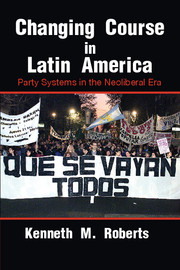Book contents
- Frontmatter
- Dedication
- Epigraph
- Contents
- List of Figures
- List of Tables
- Preface and Acknowledgments
- List of Abbreviations
- 1 Introduction: Party System Change in the Neoliberal Era
- Part I Explaining Regional Patterns
- 2 Partisanship and the Puzzle of Party System Stability
- 3 Critical Junctures and Party System Change
- 4 Antecedent Conditions: Party System Differentiation in 20th-Century Latin America
- 5 Neoliberal Critical Junctures and Party System Stability
- 6 Programmatic (De-)Alignment and Party System Stability in the Aftermath Period
- Part II National Experiencesin Comparative Perspective
- Appendix Election Results in Latin America
- References
- Index
5 - Neoliberal Critical Junctures and Party System Stability
Published online by Cambridge University Press: 18 December 2014
- Frontmatter
- Dedication
- Epigraph
- Contents
- List of Figures
- List of Tables
- Preface and Acknowledgments
- List of Abbreviations
- 1 Introduction: Party System Change in the Neoliberal Era
- Part I Explaining Regional Patterns
- 2 Partisanship and the Puzzle of Party System Stability
- 3 Critical Junctures and Party System Change
- 4 Antecedent Conditions: Party System Differentiation in 20th-Century Latin America
- 5 Neoliberal Critical Junctures and Party System Stability
- 6 Programmatic (De-)Alignment and Party System Stability in the Aftermath Period
- Part II National Experiencesin Comparative Perspective
- Appendix Election Results in Latin America
- References
- Index
Summary
Conventional wisdom suggests that LM party systems entered the 1980s with a series of attributes that should have enhanced their stability. Research on party systems in both the U.S. and Europe has found that aging electoral alignments are less stable than those forged in response to more contemporary issue cleavages (Maguire 1983: 83–85; Carmines, McIver, and Stimson 1987), and the European literature argues that the organization of class cleavages binds voters to parties and limits their mobility (Lipset and Rokkan 1967; Bartolini and Mair 1990). In comparison to their elitist counterparts, LM parties were more densely organized and had more encapsulating linkages to social groups. They encouraged competition that was more likely to be grounded in modern social cleavages and programmatic alternatives rather than disputes from the distant, oligarchic past. Whereas oligarchic party systems seemed anachronistic in the ISI era – the institutional residue of intra-elite conflicts that pre-dated the rise of mass politics – LM party systems were produced by more recent patterns of social mobilization and political competition.
A critical juncture approach suggests, however, that the modern organizational forms of LM party systems were embedded in a state-centric matrix of development that progressively unraveled in the waning decades of the 20th century. The collapse of ISI and the transition to market liberalism eroded the structural foundations of the societal linkage and cleavage patterns that had been spawned by the process of labor mobilization. As such, they exposed LM party systems to more severe exogenous shocks and deeper sociopolitical dislocations than in the elitist cases that experienced more moderate versions of the state-centric matrix.
- Type
- Chapter
- Information
- Changing Course in Latin AmericaParty Systems in the Neoliberal Era, pp. 89 - 110Publisher: Cambridge University PressPrint publication year: 2015

